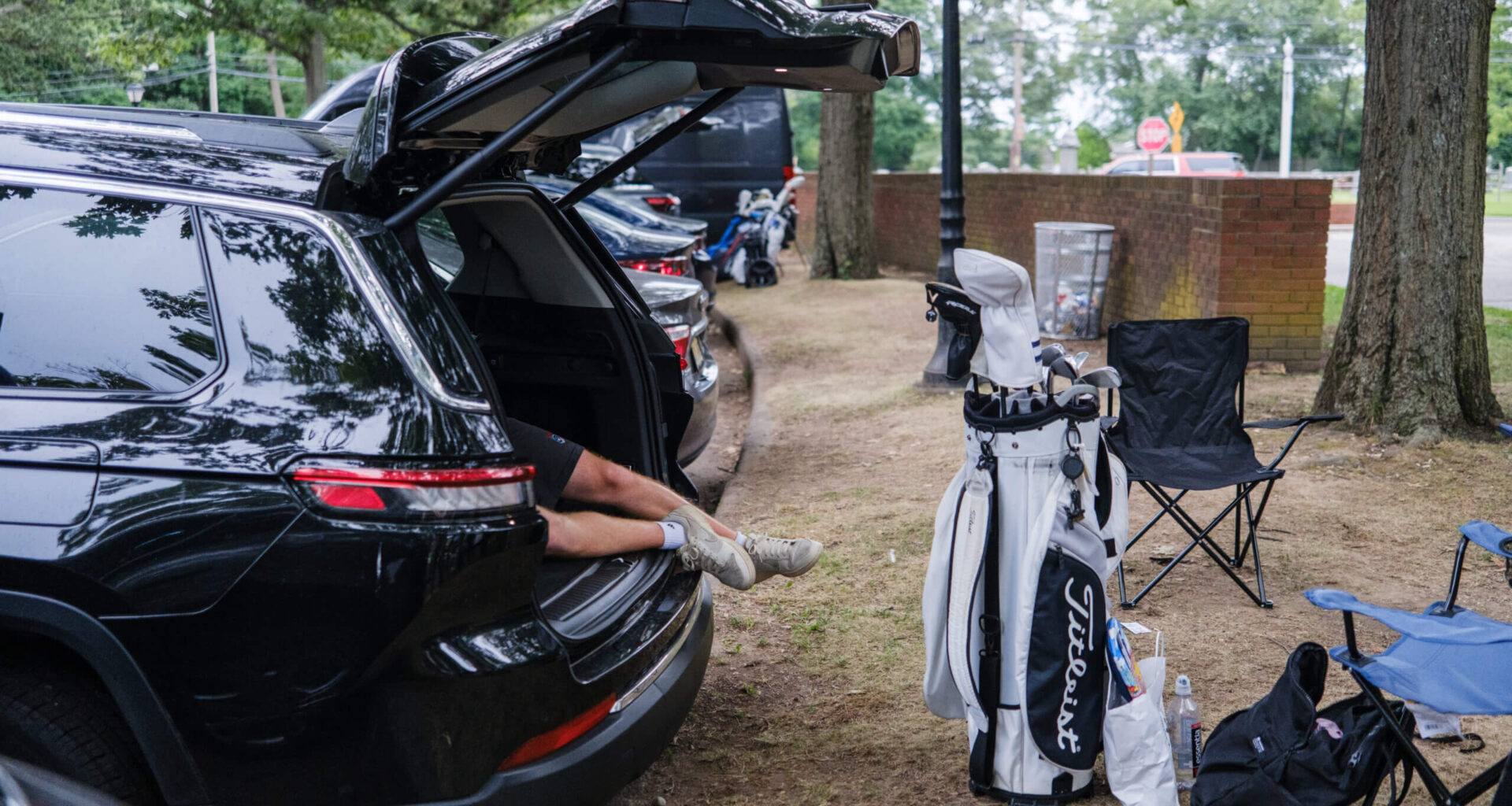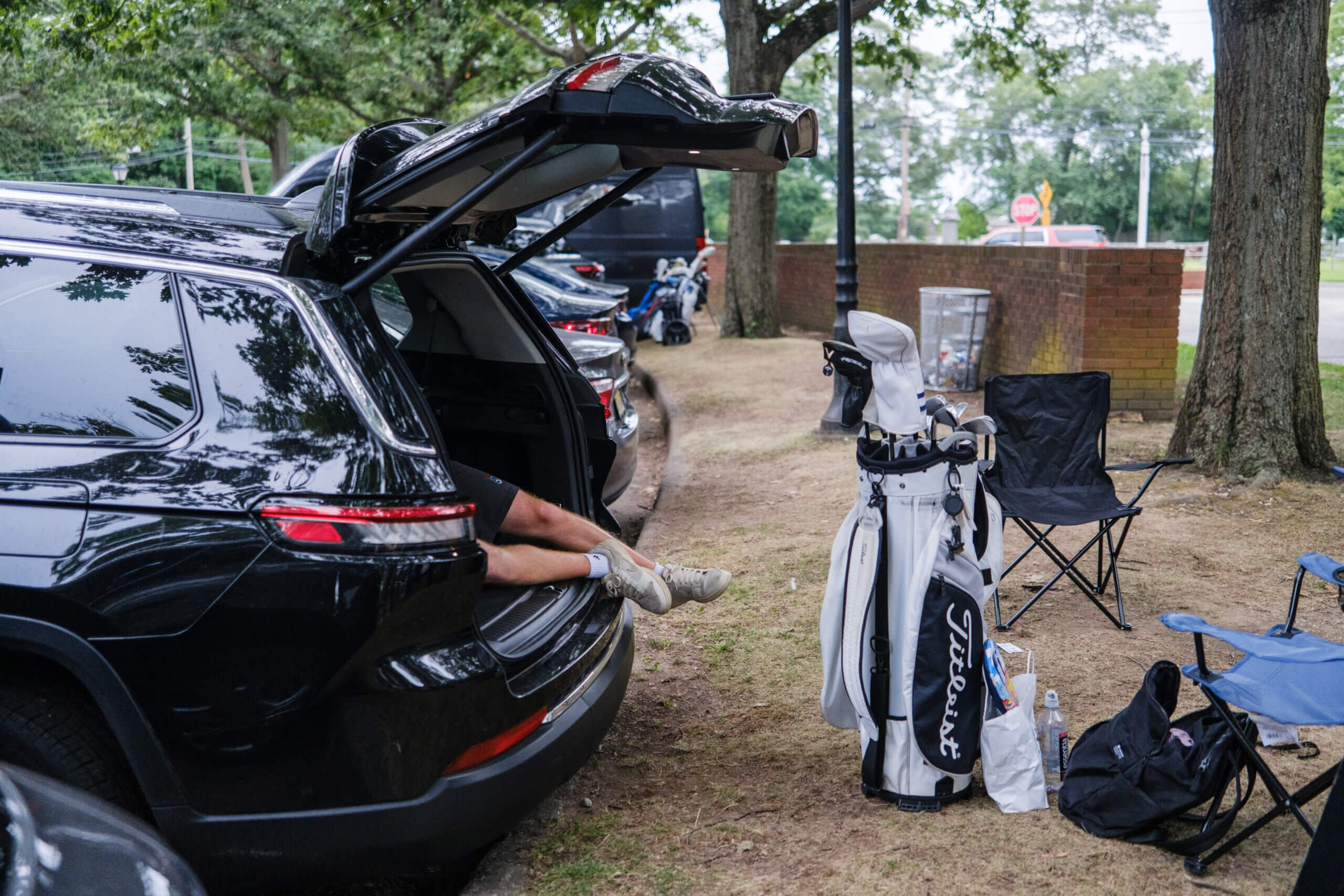 Sleeping in the trunk is all in the call of duty for golfers waiting in the Bethpage Black car line. Stephen Yang, Getty Images
Sleeping in the trunk is all in the call of duty for golfers waiting in the Bethpage Black car line. Stephen Yang, Getty Images
Editor’s note: Bethpage State Park’s infamous Black course will be the stage for the 2025 Ryder Cup – the sixth significant event on the municipal course including two U.S. Opens, a PGA Championship and two FedEx Cup playoff tournaments. In May 2002, I traveled to Bethpage State Park with Todd Graff, a friend and former Greensboro News & Record golf writer, to experience first-hand waiting in the car line to play the Black Course the week before it closed ahead of playing host to its first U.S. Open. I wrote about it for The Augusta Chronicle. The adventure begins long before you ever tee off. The characters in this story are from 2002. Some italicized notes have been added to the original text.
FARMINGDALE, NEW YORK | The stomach was grossly unsettled when we idled at the stop sign on Powell Avenue and waited for a minivan to pass.
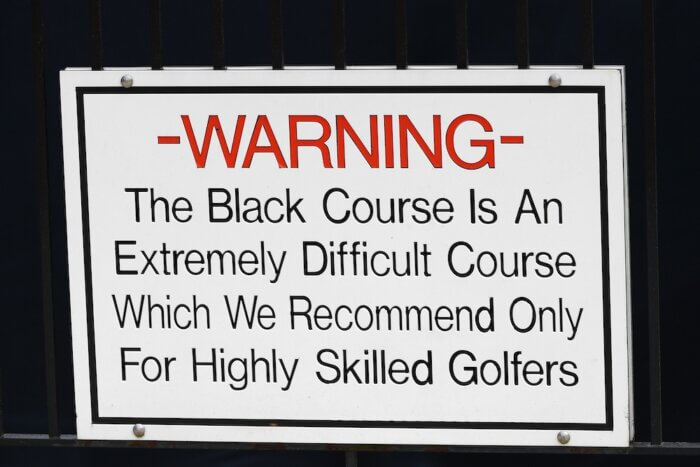 You can’t say they didn’t warn you. Ross Kinnaird, Getty Images
You can’t say they didn’t warn you. Ross Kinnaird, Getty Images
“They’re probably going to take the last spot,” I told Todd, the pessimism already eating away at the gastrointestinal system.
All in all, it seemed a little crazy. It was 11 p.m. Monday, and the two of us were on our way to play golf. Not that night, of course. In fact, not even the next day.
We were hoping to play golf Wednesday morning sometime in the range from 8 to 9. So with 33 hours to go, it’s understandable why we worried the tee times were already gone. We regretted driving all the way out to the end of Long Island to play Montauk Downs, making us so late getting back.
The offending minivan veered right, away from the entrance to Bethpage State Park. The stomach nerves, however, didn’t diminish. We turned in and sped up the straightaway toward the parking lot we’d scouted out earlier in the day. From a distance we could see the back end of a black sports car. Next to it a large white van. Next to that … NOTHING! An empty space.
Faster than necessary we wheeled into the lot, whipped around and backed into the spot beside the van. Instantly the rented Ford Focus wagon transformed into something more special. It became Car No. 3.
As we got out to confirm our bearings, the owners of Car No. 1 and Car No. 2 approached. A shorter man stretched out his hand. With a firm grip and raspy New York accent, he dismissed any lingering tension.
“Yer in!” Ray Kitson said.
By “in,” the local electrician meant in line. And by in line – in one of the coveted first six of 110 numbered spaces – we are in luck. Assuming we didn’t break any rules and weather cooperated, we would be able to spend $31 and play at 8:18 a.m. Wednesday – exactly 33 hours, 13 minutes from the time we pulled into space No. 3.
We made it. By 3:30 a.m. Monday, the first six spots were full. Before sun-up, a parade of cars came and went, other nervous stomachs surely sinking when they saw six cars already backed into line and confirmed each car would fill its allotted foursome.
Welcome to municipal golf – New York style. Welcome to Bethpage’s Black Course – the most democratic course to ever host the U.S. Open.
Car-line Culture
The car-line system is not unique to Bethpage. In metropolitan areas across the country, some public courses have long operated under a first-come, first-served basis to accommodate the eager masses who can’t afford country club fees.
But Bethpage State Park on Long Island, New York – with five colorful courses from Red, Blue, Green, Yellow and Black less than 30 miles from Manhattan – has perfected the car-line system for decades. And since the USGA announced in 1996 it was bringing the national championship to the Black course in 2002 and pumped in $3.5 million for top-notch renovation, the car line has become more than just urban legend. It’s a symbol of real golf played by real golfers.
“I can’t believe some of the things we go through to play golf around here,” said Car. No. 5’s Danny Fava of South Ozone Park, New York.
How hard is it to get a reservation by telephone? Well, in a 1998 phone survey of the 16 reservation lines, there were more than 90,000 unanswered phone calls in one-hour period. Tee times for the Black course are usually gone in the first two minutes.
To play the Black, you’ve got to love golf. You’ve got to sacrifice. You’ve got to sleep in your car at least one night for the chance to play one of the toughest courses any amateur will ever set foot on. Of course, you could make a telephone reservation seven days in advance. That’s assuming you like odds about as good as winning the Pick-4 lottery.
“It’s impossible to get through,” said Anthony Acosta of East Brunswick, New Jersey, who holds second shift in the Car No. 2 stakeout.
How hard is it to get a reservation by telephone? Well, in a 1998 phone survey of the 16 reservation lines, there were more than 90,000 unanswered phone calls in one-hour period. Tee times for the Black course are usually gone in the first two minutes.
Kitson can attest to the difficulty in getting a spot by phone. Despite being equipped with an automatic dialer and multiple lines from the local 249 calling exchange, Kitson has never gotten through for a tee time in seven years.
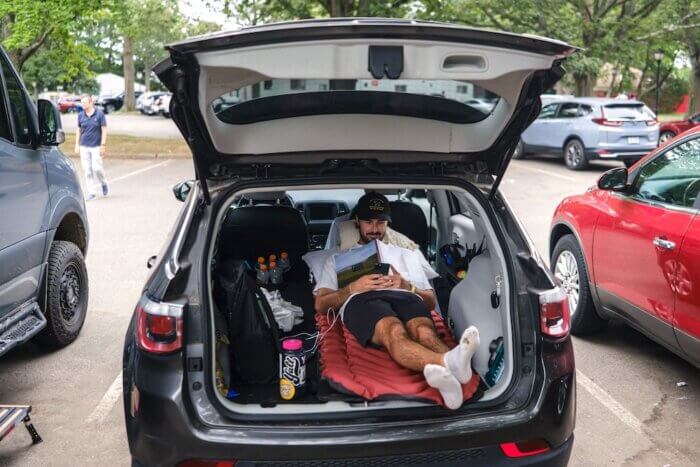 Some choose to catch up on their reading while waiting to get on Bethpage Black. Stephen Yang, Getty Images
Some choose to catch up on their reading while waiting to get on Bethpage Black. Stephen Yang, Getty Images
David Catalano [the Superintendent of Parks for 15 years until retiring in 2011] admits that of the 50,000 registered golfers in the New York metropolitan area, only 4,000 of them acquired phone reservations last year. Some of those 4,000 have success an inordinate amount of the time, suggesting a glitch in the system.
[Widespread exploitation of its phone reservation system using automated bots and phone line manipulation to unfairly secure tee times resulted in Bethpage management opting in 2024 to overhaul its reservation system and implement new policies – including cancellation restrictions, tee-time frequency limits and the elimination of dubious accounts. A new booking category was also created to ensure that only verified New York State residents get seven-day-in-advance reservation access to the park’s five courses.]
Hence the car line remains the only option for most golfers to ever get on the Black. Though it was reduced to six slots before the Open and will return to only 15 a day (the first six plus one tee time every hour) after the tournament leaves, Catalano would never consider scrapping it.
“If I had a death wish,” he said not even jokingly. “We’re dealing with a culture now.”
The Rules
The car line is simple, and the rules are plainly posted on a sign directly behind the first few spaces.
Once hacked into a numbered space, a representative from each car must remain with it until the park staff dispenses “bakery” tickets and wrist bracelets to the occupants at 4 a.m. the day of play. Anyone not in the car at 4 a.m. will not play. Anyone without a bracelet when they approach the first tee will not play.
Any vehicle left unoccupied for more than an hour will forfeit its position in line. This means you’re not tethered to the car at all times, but there’s no sneaking off to work or to play a different course.
If you think you’re going to skirt the rules, think again. The line polices itself, with anyone farther back in line all too eager to rat out someone for noncompliance. The park staff always sides with the line’s internal justice.
The evening before play, Mickey Walsh will drive by in his beat up F-250 pickup and bracelet one person for each of the first seven cars, taking name, ID and license plate numbers in the process. The person with a bracelet must be there in the morning and must play.
If you think you’re going to skirt the rules, think again. The line polices itself, with anyone farther back in line all too eager to rat out someone for noncompliance. The park staff always sides with the line’s internal justice.
“Some people complain, but they know they’re wrong,” said Danny Pepe, a park staffer for six years.
Scofflaws who’ve attempted to use dummies have returned to their vehicle to find tires slashed and the dummy hanging from the nearest tree. Every regular on line has a story about a fight or two along the way.
“We’ve had an irrational moment or two,” Catalano said.
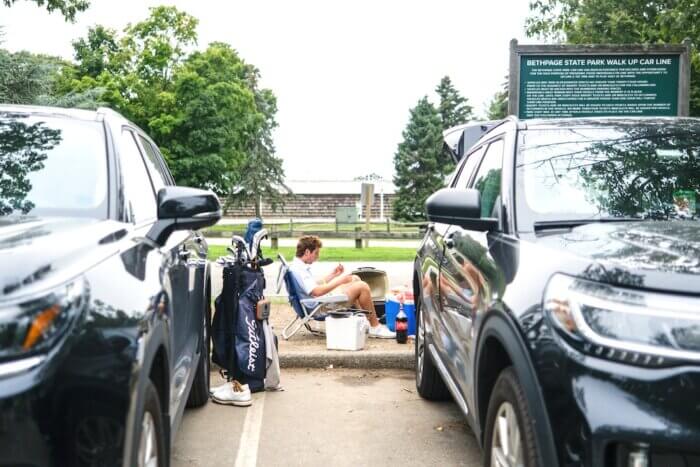 There is plenty of time for a snack as golfers wait to play Bethpage Black. Stephen Yang, Getty Images
There is plenty of time for a snack as golfers wait to play Bethpage Black. Stephen Yang, Getty Images
But the system works as intended – “to provide those individuals on line an opportunity to secure tee times and to play golf at Bethpage.” It’s as democratic and open as it gets in golf. No exceptions. Bribes – from money to marijuana – don’t work.
“I’m not certain we would take care of the president of the United States,” Catalano said.
The only way around the system is to rent the course out Monday or Tuesday – for $100,000 tax deductible donation made payable to the Natural Heritage Trust.
The Boys and Girls Club of America did just that on May 21, 2002, with the likes of Rush Limbaugh and Trent Dilfer forking over $15,000 a man to play in the charity outing.
Most just wait their turn to pay $31 – $39 on weekends – to carry their own bag. No carts are allowed on the Black. It’s a grueling walk. “When you cross the road (to the 15th tee), you want to die,” Kitson said.
[Green fees in 2025 are $70 for weekdays and $80 weekends for New York State residents and $160/$180 for out-of-state golfers.]
Actor Steve Guttenberg camped out recently. NBC golf analyst Roger Maltbie and his TV crew waited 36 hours in line after their first try was rained out. Four New Jersey Devils players went from elimination in the Stanley Cup playoffs to the car line, enduring another rainout and two nights in the car before playing, then heading home to Canada.
Down to the Wire
Bethpage limited access to the course leading up to the U.S. Open. Only 30 tee times a day were allowed, all between the hours of 8 a.m. and 1 p.m. The first six tee times – 24 players – were set aside for the car line.
The closer the Open drew, the more competitive it got to get a spot. The rules specifically place a limit of 24 hours on waiting, but Catalano said enforcing that would only create more problems.
“We’ll have people staking out the car line and racing to get to the spots,” he said.
So the line bends a little. But only six playing days before the course closed on May 28, 2002 – and the attraction of playing the course in conditions as close as possible to what the U.S. Open participants will experience – space was at a premium.
The Wednesday spots were filled 29 hours in advance. Thursday hopefuls began queuing before lunch Tuesday – 44 hours early. By Tuesday night at 11 p.m., Friday slots were gone with 57 hours to spare. By Wednesday afternoon, half of Saturday was filled.
“It was fairly insane before. Now it’s completely insane.” – David Catalano
Word of mouth was spreading that the times were evaporating and the wait time growing exponentially. When Kitson rolled by at 5 a.m. Thursday on his way to work, he was told every spot was booked through Monday. Those guys would be waiting as many as 100 hours for the chance to be among the last hacks to play before the Open.
“It was fairly insane before,” Catalano said. “Now it’s completely insane.”
One observer to the developing spectacle agreed.
“I think some psychiatrists should come around here and start talking to people,” said photographer Ed Betz. “Cuz some of these people ain’t right.”
You might count Mike Daley of New Hyde Park, New York, among them. He just missed out on a Wednesday spot, so he decided to return later that night to secure a place for Thursday. When he returned at 10:50 p.m. Tuesday, he was just in time to fill the last spot for Friday. Without flinching he backed his blue van into the line.
“I’ll call a couple of friends and see if they’ll split time with me,” Daley said. “If not, I guess I’ll just have to suck it up.”
Daley is more prepared than most. His van has a bed, television and VCR, mood lights, cheese doodles, a cooler of soda and two James Patterson novels. He also has a coffee-table size book entitled “How To Play Golf.”
“I guess I got 60 hours to figure it out,” he said.
The Wednesday Six
Guy Sulzberger, a 20-something financial consultant from Hoboken, New Jersey, knew nothing about Bethpage Black until all the recent fuss and the media leading up to the U.S. Open. But with permission from his boss (and a promise to make room for him on the first tee) Sulzberger headed to Long Island to see for himself.
He became Car No. 1 a few minutes before 10 p.m. on May 20.
An hour later, Kitson cruised from his Farmingdale home just around the corner. Seeing Sulzberger’s car already in position, Kitson took no chances and secured Car No. 2. With only one round allowed per person until after the Open, Kitson waited until the final week. He couldn’t wait any more.
Kitson grew up playing Bethpage’s courses. Like every other public golfer in the New York area, he considers the Black course to be the ultimate test. Since the USGA tapped it for the Open, Kitson and his cronies have become fanatical advocates for the course and its merits.
“It’s all we’ve been talking about for five years,” he said. “It’s like a bunch of drunks at a high school reunion talking about the glory days. If the pros tear it up, that will certainly humble me.”
[Tiger Woods was the only player to break par (3-under 277) in winning the 2002 U.S. Open by three shots over Phil Mickelson.]
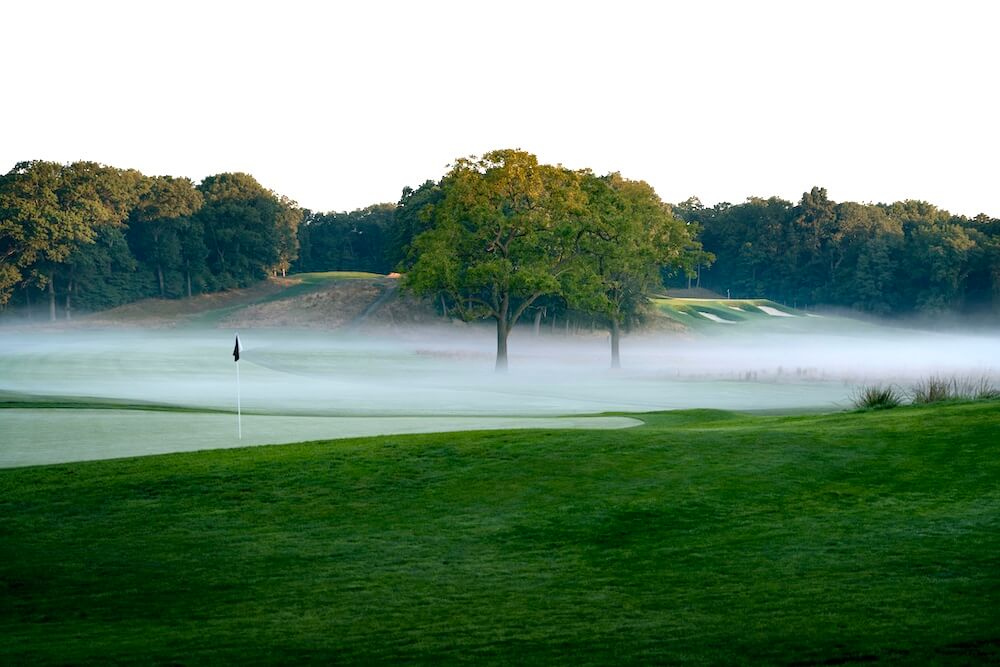 Eyes on the prize: An early-morning look at Bethpage Black. Gary Kellner, PGA of America via Getty Images
Eyes on the prize: An early-morning look at Bethpage Black. Gary Kellner, PGA of America via Getty Images
Thirty minutes before the 24-hour waiting period technically began, all six spots were gone. More cars cruised through without stopping; others paused to grumble about the good ol’ days when most people avoided the Black course because it was too hard.
“The Open’s the worst thing that ever happened to this place,” said a regular in a Suburban with New York plates. “I’ve played this course 300 times and now I’ve got to wait 48 hours to play it? Ridiculous!”
Shortly after 5 a.m., Scott Scannell of Smithtown, New York, coasts through in his black F-350 pickup. He is about to pull away when he hears a guy leaning into Car No. 4 say, “You think you’re playing Tuesday?” Scannell stops.
Fifteen minutes later, Car No. 4 pulls out. Cars 5 and 6 move up and Scannell back’s his truck into space No. 6.
“Silly guys,” said Ed Parlow, a Honda dealer from Bethpage, New York. “They thought they could get here to play the same day.”
Scannell laughed loudest. In the chill morning, the construction worker climbed out of his truck and danced in the parking lot. He called his brothers on a cell phone: “We’re in!”
By that evening, Scannell and his brothers had a $250 rented RV camper, bringing their costs for playing an Open venue to $93.50 a man – still a bargain.
Ties that Bind
The line builds its own bond. It’s largely a male ritual, because most of the car line agrees that women are either too smart or don’t care enough about golf to go to all the trouble.
And the line tends to lose touch with their feminine sides. Scannell realizes he was waiting to play on his wife’s birthday, for which he was planning a family party.
“Oh well, I’ll be there in the afternoon,” he said with a shrug.
Kitson said he was “public enemy number one” in his house, and the situation wasn’t helped when his partners kept calling him at 3 a.m. to make sure he’d be back in line in time. When his wife confronted him, his child-like response was, “but I gotta, I gotta, I gotta!”
Scott Alexander in Car No. 4 spent this eight-hour shift cuddling and doing needlepoint in the back of a Honda Odyssey with his girlfriend. Sulzberger’s girlfriend, Lindsay, had been on a trip for four days and figured driving 90 minutes was the only way she’d see him for two more.
The only two women associated with the Wednesday six are girlfriends just visiting.
Scott Alexander in Car No. 4 spent this eight-hour shift cuddling and doing needlepoint in the back of a Honda Odyssey with his girlfriend. Sulzberger’s girlfriend, Lindsay, had been on a trip for four days and figured driving 90 minutes was the only way she’d see him for two more.
The only other women to get remotely close to the culture Tuesday remained a good half-wedge away in nearby trees talking on their cell phones.
“Seventy-seven yards to be exact,” said Ken Harms after checking the yardage with his range finder. Harms is the husband of LPGA golfer Emilee Klein and the caddie for three-time U.S. Open champion Hale Irwin. He stopped by to check out the course and hoped he might squeeze into a vacancy in somebody’s foursome.
He couldn’t, but the candid conversation with Harms killed off two hours which might have been more if Acosta hadn’t kept referring to Harms’ boss as “Hal Irvin.”
Killing Time
To all those who think waiting in line for golf is crazier than camping out to see Star Wars: Episode II, you’re missing the point. More socializing happens in 24 hours in the Bethpage parking lot than in any other average day loose in the free world.
Scannell brought coffee, hot chocolate and Entenmann’s cakes for everyone in line during the introductory hours. Sulzberger fired up his laptop to spend it on a conference call. Acosta ended up dog-sitting a hyperactive golden retriever named Gussie (short for Augusta National) for a stranger operating a scoreboard for the outing.
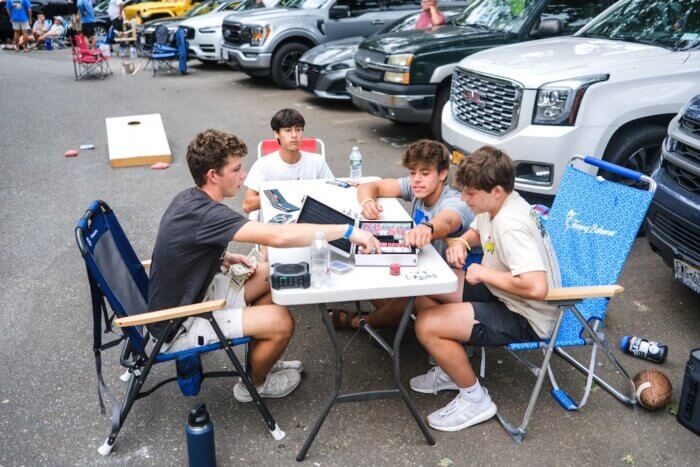 A game of poker or cornhole are ways that some choose to pass the time in the car line. Stephen Yang, Getty Images
A game of poker or cornhole are ways that some choose to pass the time in the car line. Stephen Yang, Getty Images
Everybody would while away hours wandering through the clubhouse, eating in the Oak Room, practicing putting or peeking at the Black course that awaited. Nobody strayed for longer than the allowed one hour.
The more seasoned veterans display their savvy. Chris Parlow had the entire “Godfather” trilogy on the DVD player in his dad’s fully equipped Odyssey. Fava had glasses to pour his Guinness into in order to escape the park police shakedowns. Barbecues are illegal but often overlooked.
A favored late afternoon activity was sneaking one at a time into the clubhouse locker room for a clandestine shower that served as an instant recharger. Then it was pizza time and cocktail hour (no park police in sight) until Walsh showed up at 7:50 p.m. to dole out the coveted wristbands.
The park police flexed their muscle again at nightfall, ordering lights out at 10 p.m. and threatening to banish anyone found outside their cars who wasn’t on his way to the bathroom.
Start Your Engines
At 4 a.m. Danny Pepe rolls up in his park pickup, and the last chapter of the Bethpage experience begins. The cars carefully keep an order, filing past Pepe for bakery tickets and additional wristbands that give you the right to proceed immediately to pay greens fees.
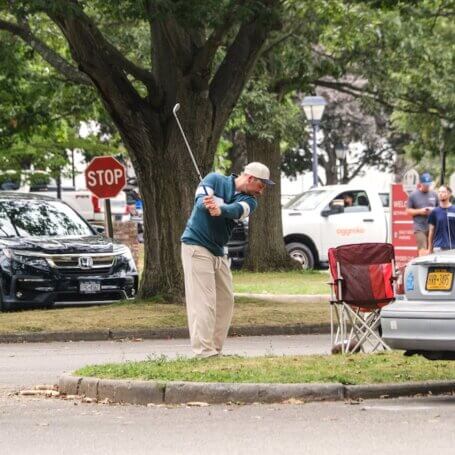 With a multi-day wait to get on Bethpage Black, there is more than enough time to stay loose. Stephen Yang, Getty Images
With a multi-day wait to get on Bethpage Black, there is more than enough time to stay loose. Stephen Yang, Getty Images
In a normal season, play begins at 6 a.m. But with the U.S. Open looming, there were four more hours to kill at a local diner and a nearby driving range.
“What am I doing here?” said Danny Fava in a brief moment of clarity the afternoon before. “I want to play the course that the pros are going to play. I want to play it like they’re going to play it. I can’t miss this.”
We spent 33 hours biding time and building relationships. We’d gone from total strangers to first-name acquaintances. Everyone in Cars 2 through 6 stand behind the first tee and watch their comrades nervously tee off in front of them. Guys who would never have spoken to you before are now ribbing you about your backswing.
And when it’s all over and the course has had its way with most of the weary lot, the same question is asked over and over again.
“Was it worth it?”
You bet.
Click HERE for a detailed timeline of the Bethpage Black car-line experience.
© 2025 Global Golf Post LLC

